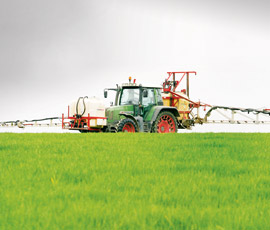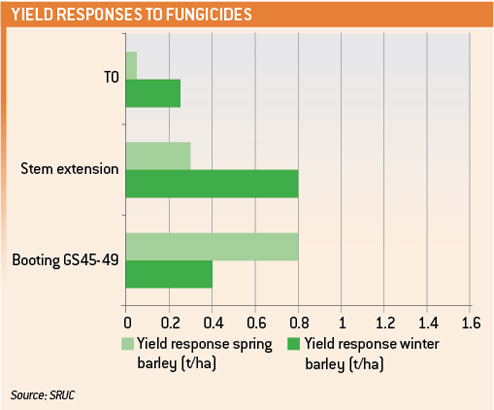Early fungicide spray can keep barley diseases at bay

An early spring low-dose fungicide paid dividends in many winter barley crops last year, giving a yield benefit and an insurance against catchy weather later.
This T0 application in March has given an average yield uplift of 0.25t/ha over the past decade and across a range of varieties (see graph) says Fiona Burnett, applied practice team leader at Scotland’s Rural College (SRUC).
“Only about a third of growers use a fungicide at this time, but it was definitely the right decision in 2012. I suspect more will do so this year, especially in crops aimed at the malting market,” she says.
The aim is to apply a protective, low-dose fungicide to prevent over-wintered rhynchosporium and net blotch from getting an early hold – the former is especially difficult to eradicate, she notes.
There are plenty of choices at this early stage, but Dr Burnett prefers to reserve azole chemistry, which includes the triazole group of products, for later applications.
“There is a lot of talk about reduction in efficacy so it makes sense to use something different, ” she says.
Kayak (cyprodinil) at 0.5l/ha plus a morpholine such as Torch (spiroxamine) at 0.3l/ha is her choice.
“You don’t need too much persistence, just a quick hit. The morpholine adds a bit of kickback against rhyncho and net blotch and will help control any mildew that’s there,” she says.

Growers with resistant varieties under little disease pressure might want to weigh up the benefits. “However, rhyncho ratings are not bullet-proof, and even seemingly resistant varieties can get relatively high levels under pressure,” she adds.
As with all barley fungicide timings, the T0 goes on earlier than wheat to allow for the plant’s rapid growth habit. GS 23-24 is ideal, leaving about three weeks to T1 at early stem extension, the most important timing of all in the winter crop.
“This application is the key yield protector, reflecting barley’s reliance on tiller numbers to produce grain sites,” says Dr Burnett. The rolling average response to T1 fungicide over the past 10 years is 0.8t/ha, she notes.
The main decision is whether to base the spray on SDHI or triazole chemistry. Prothioconazole (Proline) remains very strong, and should be mixed or formulated with fluoxastrobin in a 1:1 ratio (such as Fandango) or with chlorothalonil (such as Bravo), she advises.
Ramularia ratings
Ramularia resistance ratings are being introduced to the 2013-14 spring barley Recommended List, reflecting the disease’s increasing importance. All major varieties are susceptible to a degree.
“While it will erode yield its main effect is on quality,” says Dr Burnett. “The disease has not been on people’s radar until recently. We would hope to see better scores coming through in newer varieties, but that won’t be for a few years.”
Other triazoles, even epoxiconazole, are technically poorer,” Dr Burnett notes.
An SDHI addition improves performance on high-risk net blotch sites and when it comes to eradicating established rhynchosporium, useful where no T0 has been applied.
Siltra Xpro (bixafen + prothioconazole), Adexar (epoxiconazole + fluxapyroxad) and Ceriax (epoxiconazole + fluxapyroxad + pyraclostrobin) all performed well in this role against rhyncho in HGCA trials over a three-year mean.
In terms of yield the three-year mean shows little difference between those three SDHIs and Proline at around the 50% dose Dr Burnett recommends at this timing.
“There is some evidence that raising the rate of Siltra Xpro to 0.6l/ha can help – this produced a 0.3t/ha advantage over 1l/ha of Fandango in our Lanark trial last year,” she says
At T2, typically applied at GS 49 (booting), ramularia joins the list of target diseases. It has increased in prevalence in recent seasons.
“It is endemic in crops but is usually symptomless, only breaking out to complete its lifecycle at the end of the season.” Increasing use of strobilurins and resulting greener crops may have helped it proliferate, she adds.
Growers can judge at GS30-31 (T1) whether it is likely to become a problem, as levels in upper leaves depend on leaf wetness (heavy dew is enough) at stem extension. “Make a note so you can take appropriate action.”
Dr Burnett recommends similar chemistry to T1, favouring Siltra Xpro at around 40% of full dose plus chlorothalonil for its better performance against ramularia. “Proline also remains strong,” she adds.
Growers concerned about ear diseases – both michrodochium and fusarium were widespread in 2012 – can put back the T2 to GS 59 (ear emergence) she advises. “Both Proline and Siltra Xpro can now be used to ear fully emerged.”
With spring barley many growers try to get away with a T2 spray only. In low disease years that may pay, though mildew-prone varieties will need watching, says Dr Burnett.
“If crops are spotless that’s an option. The danger is that disease could become established before T2, leaving growers trying to clean crops and jeopardising grain sites. There is an element of insurance here; I would advise anyone growing for malting to go at T1.”
A 0.6l/ha rate of SDHI is best where disease is present or likely, otherwise a half-rate Proline plus Bravo should be enough to ward off rhynchosporium, net blotch and, in the south, brown rust.
T2 is the key fungicide timing for spring barley, producing a 0.8t/ha uplift on average over the past decade.
“Ramularia is more of a risk in the spring crop. Fandango and Proline are good options, but I’d lean towards 0.4l/ha of Siltra Xpro plus Bravo, especially in a malting crop or if rain is forecast. That would tick every box.”
Some timing flexibility is possible.
“If only applying one spray you could go at GS37 (flag leaf), but that would be too early to manage the ear disease complex. Starting them might be OK if growing for a large feed acreage, but if you are after quality nearer T2 is better.”
A three-spray approach can pay on spring barley
The spring barley area in Mark Glyde’s Hampshire/Wiltshire/West Sussex core area is set to increase by about 30% this spring.
Mr Glyde, a partner at Petersfield’s Crop Management Partners, says many growers will be returning to the crop after several years. One important thing to remember is the speed at which the crop can develop.
“It’s easy to get caught out and miss the optimum timings,” he explains. Last year many agronomists, including him, opted for three timings due to the wet weather and disease pressure, and he will be prepared to repeat that this season.
However, good disease control starts earlier, Mr Glyde points out. “We grow a lot of spring barley here and we’ve found the most important thing is a healthy plant.
“Drilling is probably more important than fungicide use – if the crop emerges slowly from a cold, capped seedbed it is always going to struggle, so going early is not always the answer. ADAS Bridgets carried out years of work and found crops drilled between 5 and 10 March performed the best.
A litre of chlorothalonil at mid-tillering is very cost-effective insurance, he maintains. This tends to be followed with a 0.3-0.5l/ha of Siltra Xpro at GS30, which has largely replaced his previously favoured approach of 0.6l/ha of Fandango.
Where people don’t want to spend so much or if as last year Siltra Xpro is in short supply he’ll use half-rate Proline plus 0.75l/ha of Amistar Opti.
“It’s a good combination – it has the prothioconazole and chlorothalonil to tackle rhyncho, net blotch and ramularia as well as strobilurin for added rust control.”
He tends to hold his T2 spray until awns are at the “paintbrush” stage. Siltra Xpro is favoured here for its extra kick against ramularia, at 0.2-0.4 litres depending on disease presence and activity.
“Hopefully this timing allows us to keep ahead of disease and provides a bit longer protection. I wouldn’t want to delay much more as it is good to get in ahead of pollen scorch.”
Typical target yields range from 6.5 to 7.5t/ha, and both feed and malting crops will be treated the same. “Feed barley is currently worth £170/t, only about £10/t less than malting, and is well worth protecting.
“You could cut the early chlorothalonil if there was no disease pressure, but I wouldn’t cut back any more. Spring barley may be less responsive than the winter crop but it is still important to produce a clean, bold and bright sample.”
Read more articles on fungicides
Four new fungicides to tackle oilseed rape disease
Disease control is a priority with grain prices high
Higher spend pays off in tough disease year

